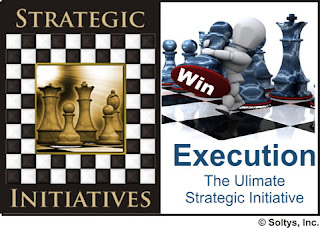Yes, there is always planning, analysis and preparation for any initiative, but often these become the activity rather than actually executing the plan of initiative. Too much time and energy spent prior to execution can really water down the excitement and momentum. It is also a wonderful point to showcase strong leadership in action. Here are a few tips that might be helpful.
I always find that working toward successful execution works best working backwards from the “Go Live” date. The Go Live date drives so many other factors and becomes a quick reality check. Consider the timing of the Go Live date in conjunction with other internal or external events and commitments. The advantages that can be gained by planning to either coincide with something where you can ride a wave, or be the stand alone that gets all of the attention, can be critical in terms of impact. On occasion an initiative has a quiet rather than celebrated Go Live, especially when the initiative solves a complicated issue that does not need any more attention.
Delegate! Even though you may be the best and the greatest, sharing the work with others not only helps, it takes some of the burden. It also helps others to be engaged, share the excitement and add valuable ideas and energy.
Communicate! Communications are critical and need to include status checks and information updates on a regular basis. Communications are a part of your leadership responsibilities in delegation. Consider grouping email and other near instant communications so that there is an expected update communication rather than a barrage of unorganized stream of consciousness emails. Too many communications means that the recipient may not see the order and react to the oldest first or the newest without the needed preliminary information. It also helps so that someone does not feel overwhelmed and ignore or pick and choose communications. If the initiative is not a secret, have periodic updates written to build anticipation.
Set milestones and celebrate milestones successfully met. Milestones celebrated help everyone feel the forward momentum. It also allows the list to be reduced, which helps with the feeling of accomplishment.
Don’t get buried in the details. Details may make or break the success, but the leader cannot be involved in each. It erodes the empowerment built in delegation and creates an environment of micro-management which can be perceived as the expected style. Attention and acknowledgement of the details with inspection will be preferred.
Comment, compliment and catch people doing things right. One of your biggest roles as a leader is to reward behaviors, actions and accomplishments proactively. Sometimes, it’s important that you notice or recognize effort and impact in front of others. This builds the team and creates allegiance to you and the initiative.
A leader is always valued, known and revered by the initiatives successfully executed. They are often remembered for their failures. Communication and engagement will often determine the perspective. Using the tips given, a great leader will be able to avert, mitigate or change course so that failures never see a Go Live date.
As you consider the strategic initiatives for 2012, remember that execution of each is the ultimate strategic initiative.
This post concludes the Strategic Initiatives series and our Soltys, Inc. blog posts for 2011. We certainly wish you, your company and family the best of holidays and a prosperous new year. Thank you for your readership.
The 2012 Blog Series begins with Launch in January, Loving and Business in February and Lucky in March. In January we will also run a fun participation contest to help you launch some of your initiatives.













